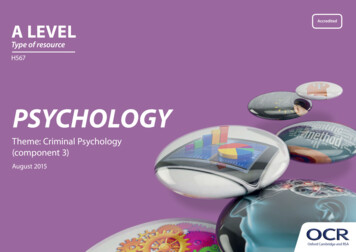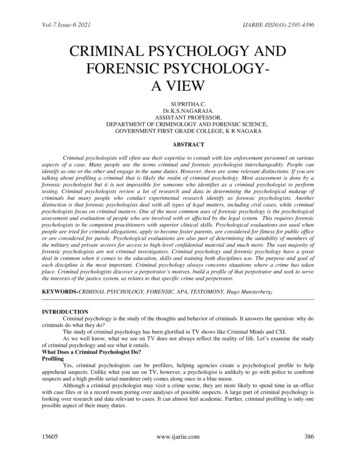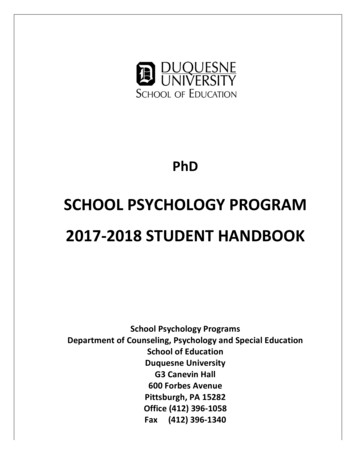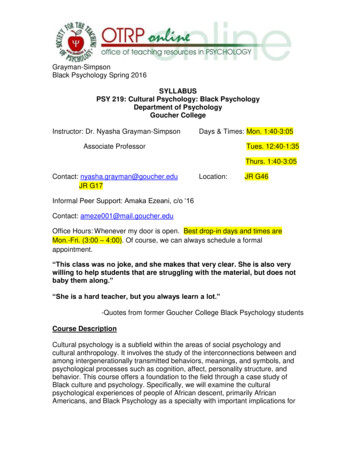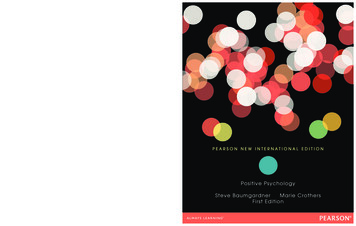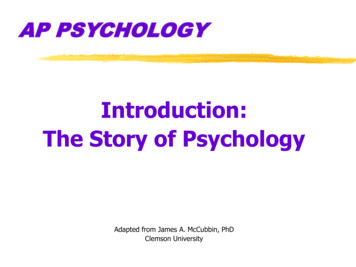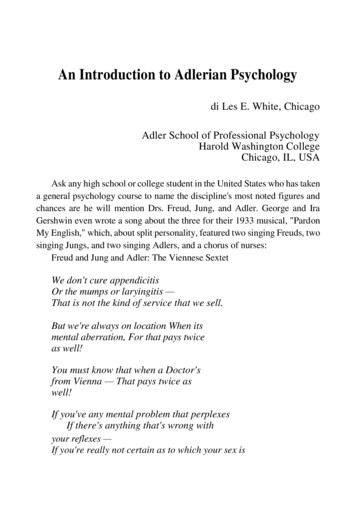
Transcription
An Introduction to Adlerian Psychologydi Les E. White, ChicagoAdler School of Professional PsychologyHarold Washington CollegeChicago, IL, USAAsk any high school or college student in the United States who has takena general psychology course to name the discipline's most noted figures andchances are he will mention Drs. Freud, Jung, and Adler. George and IraGershwin even wrote a song about the three for their 1933 musical, "PardonMy English," which, about split personality, featured two singing Freuds, twosinging Jungs, and two singing Adlers, and a chorus of nurses:Freud and Jung and Adler: The Viennese SextetWe don't cure appendicitisOr the mumps or laryingitis —That is not the kind of service that we sell.But we're always on location When itsmental aberration, For that pays twiceas well!You must know that when a Doctor'sfrom Vienna — That pays twice aswell!If you've any mental problem that perplexesIf there's anything that's wrong withyour reflexes —If you're really not certain as to which your sex is
Les E. White—We are positive that you had better see DoctorFreud and Jung and Adler, Adler and Jung andFreud —The number was cut before the show hit Broadway.1Though Freud (1856-1939), Jung (1875-1961), and Adler (1870-1937)are often grouped together, largely because they were at the forefront of thepsychoanalytic movement at the beginning of the last century, their theoriesdiffer markedly, especially Freud's from Adler's. Though the three were oncecolleagues, members of Freud's legendary Psychoanalytic Society that metweekly in Vienna (indeed, Jung and Adler are often referred to as disciples ofFreud), Adler was the first to leave Freud's "circle," in 1911. Jung left in 1913.Adler vehemently disagreed with Freud's concepts of determinism, thelibido and infant sexuality, and the structure of the psyche: that it could bedivided into conflicting parts or energies (id, ego, superego). Regarding theirrelationship, Freud was incensed when he learned that the University ofVienna was teaching Adlerian psychology in the early 1930s. Whereas Freudfelt that Adler's theories could be taught and learned in two weeks, his, bycontrast, would take at least four or five years — and then a student wouldonly begin to understand it!Freud's opinion speaks volumes about the simplicity and elegance ofAdler's theory. It suggests that every man can easily understand Adlerianpsychology and, thus, apply it to his well-being and that of society. Abasic understanding of Adlerian concepts and how Adlerians today assesspersonality and mental health shows how influential Adler's theories aretoday in the United States, especially with regard to the popular brieftherapy movement. It is not unusual for a case — from assessment tointervention to termination — to take only a few sessions.1Gershwin, G. & Gershwin, I. (1933), Freud and Jung and Adler: The Viennese sexted. Retrieved July17, 2006 from http://home.att.net/ Adlerian/lyrics.htm.
An Introduction to Adlerian PsychologyAdler's ConceptsAdler's main concepts, all of which are interconnected, ,phenomenology/subjectivity, the influence of one's social field, whichconnotes individual choice, "Social Interest" (contribution to society),and the "law" of compensation.HolismHolism is the idea that mind and body, including the psyche, areindivisible. The "state" of one's mind or how one thinks affects the bodyand vice versa. The mind can not be divided into various conflicting partsor sections (i.e., id, ego, superego). There is not a separate unconscious,but rather the person remembers what he wants to remember and thatwhich supports his style or view of life: how he perceives the world andhis place in it. A "game" I play with my students, to help them understandthe concept of holism, involves asking them to stand and raise their lefthand and right leg. I ask them to circle their left hand in a clockwisemotion and then, at the same time, to circle their raised right leg in acounter-clockwise motion. The students soon laugh because they findthat, without thinking about it, they begin to move their leg and hand inthe same direction! The analogy is that mind and body "move" together:as stated, a physical symptom affects one's state of mind, one's state ofmind affects one's physical body and the world around him. Anotherimage that also helps to understand the concept of holism is that of a car.A car is made of many parts but all the parts work together so that it canmove in one direction.For example, a client of mine, age ten, had trouble walking. He wasoften sick and "blue." A medical checkup revealed no medical causation.However, not being able to walk and often being sick and blue enabledhim not to attend school, where he was pressured to join a gang and sell
Les E. Whitedrugs. Being sick also prompted his grandmother, with whom he lived, topity him and pamper him, provide him with his favorite meals and buyhim a television set that she could not afford — all in efforts to cheer himup. The client had "arranged" his symptoms holistically and purposely —if unconsciously, or out of his awareness — to evade school and "get"goodies (please note that "unconsciously" is an adverb denoting "withoutawareness" and should not be confused with the psycho-analytic term "theunconscious").Goal directed BehaviorThe above example demonstrating holism, that mind and body movetogether, also suggests goal oriented behavior, or what the Greeks calledteleology: to what or to which goal(s) is one's behavior directed? For whatmeans? If a person were lost, would another person ask that lost person"From where did you come?" No, the lost person would be asked "Whereare you going?" Knowing a client's direction or goals helps a therapist tounderstand how that client views life. A therapist who knows his client'sdirection or goal(s) can suggest more positive behaviors to enact to reachthat goal. For example, a client whose goal is to be more powerful thanothers can bully others — or can gain that power through knowledge, say,education, and help and lead others.Goal orientation, thus, suggests movement and purpose: that allbehavior is purposeful, toward a goal or set of goals. Even if a personappears to act conflicted, we must ask what is the direction or movement— the goal, purpose — of that conflict. Often, the goal is to stay stuck inthe same rut or to confound others. A person who can not decide whetherto give up his wife or mistress may just want to "keep" both!Phenomenology/SubjectivityDetermining one's unifying themes, goal-orientation and purpose(s)
An Introduction to Adlerian Psychologyof behavior involves getting an idea of one's beliefs, or belief system:how that person believes or perceives the world and his place in it. Thisis known as phenomenology, or one's subjective view of life. All of usconsider life from our own "lens," based not so much on our experiencesas, rather, the conclusions, or values, we have drawn from ourexperiences. What do we expect of the world? What are our expectationsof new situations, or of men and women, and how do we act according toour expectations?The Social FieldHow we arrange our world and see it subjectively is "colored" by oursocial field. What are or were the values and beliefs held by our family,the neighborhood we grew up in, the schools we attended, ourgovernment, religion, and ethnic group, etc.? What was our position inour family-of-origin and early neighborhood, vis-a-vis others, and howhave we "carried" this into adulthood? What were the values which werepresented to us — say, be a good boy, study hard, be lazy, go to church,trust or don't trust others but, more importantly, what were theconclusions that we drew from these presentations: the attitudes we madeconcerning them? Did we follow or rebel against the values that werepresented? For example, the parents of a client of mine valued education,both parents having advanced degrees. My client followed this "guidingline" and went to college; his sister rejected this value and, to carve outher own personality and/or make herself significant in her family in adifferent way, did not attend college. Recently I attended a lecture givenby a famous American newscaster who spoke about her early life and thevalues of her family. Both of her parents had rejected religion. However,the family of her best early school age friend embraced religion. As achild, the newscaster was impressed by the closeness showed by thisfamily and their devotion to their religion's rituals. The newscaster brokewith her family and embraced religion.
Les E. WhiteIndividual Choice and CreativityThe values and beliefs that were presented to us as guiding lines andwhich we accepted and/or rebelled against — chose or not chose to follow— reflect that we are all creative, choosing individuals. If we chose oneway, given what was available to us, can we not choose another way?What were/are the choices that we made and continue to make: which notonly have helped us to organize our personalities and views of the worldbut which continue to support our expectations of the world? How haveour choices made us feel significant — to ourselves and to others, thathelp us to feel or not feel a sense of belonging to the wider world? Thisidea of choice — individual choice — presumes that Adlerian psychologyis a psychology of use and not possession: that is, Adlerians consider"how we use what we have." For example, a person is born into wealth.Does-that person use that position to exploit or to help others? A personis born into poverty, or is sexually abused. Does that person continue thecycle of poverty or make choices to get out of poverty? Does the personwho is sexually abused thus sexually abuse others or choose anotherroute? A person becomes crippled. How does that person "use" thatillness? To blame others? To expect pity from others? To bear a grudge?To be depressed? Or, does that person make different choices: to makethe best of his or her situation and to contribute to the well-being ofothers?This idea of how one uses what one has also includes one's hereditaryor biological make-up. What does a male make of his masculinity andhow does he use his status? How does a woman use her femaleness? Thefamous Olympic runner Wilma Rudolph who won three gold medals atthe 1960 Rome Olympics, had contracted polio, scarlet fever, andpneumonia as a child. At one point she had even lost the use of a leg. Toget a sense of positive belonging, she chose — and was encouraged byothers to participate in team sports. If intelligence is biologically based,what Adlerians consider more important is how that person uses that
An Introduction to Adlerian Psychologyintelligence — again, to help others, or to exploit others, or to be lazy,etc. It is not unusual to hear an intelligent student say "I could have donewell had I applied my smarts."Creative choice and how we use what we have suggests softdeterminism" as opposed to determinism which denotes a narrow "causeeffect" relationship. One's childhood experiences do not cause one to acta certain way. One's childhood situation influences the choices that thatperson makes. Again, is poverty a cause for more poverty, or can we viewpoverty as a set of situations and influences that do not present manypositive choices? Just as one person can decide that there is nothing hecan do to escape poverty, another person can decide differently, or viewpoverty as a motivator to get out of it: through education or even,conversely, through crime. Consider one's family-of-origin. Does everysibling behave the same? Why not, given that the siblings grew up insimilar circumstances? If their father was mean, does this cause each childto fear others or to model themselves after their father? Choices are madeand, with regard to early personality development, generally out of one'sawareness.The example of birth order or, rather, how one responds/responded toone's birth order position, is a great way to introduce clients to Adlerianpsychology as it shows very simply how decisions are made out of one'sgeneral awareness. If an oldest child, say, is encouraged to "act like anoldest" — which generally means to be responsible and lead others —and assumes that position, does the next child compete with the oldest tolead or does this next child, perceiving that the leadership position hasbeen taken, decide to rebel and/or choose other interests? If this secondchild overtakes the first in terms of leadership abilities, does the oldest"give up" and feel "less than" others? This idea of individual choice —that each of us arranges our world and looks at life from a differentposition — is why Adlerian Psychology is also called IndividualPsychology.
Les E. WhiteSocial InterestMan is a social animal. Each of us defines ourselves vis-à-vis others(even a hermit defines 'himself as "apart from others"). Adleriansconsider and plan interventions based on how each of us contributes orcan contribute to our social world. Adlerian Psychology has a reputationas a "positive" psychology because the concept of Social Interest involvesthe idea that each person has the potential to contribute positively to thebetterment of the world: to provide better social institutions andencourage positive choices and behavior, and to give others a sense ofpositive belonging. Good mental health, thus, is a reflection of ourcontributions to others. Hence, Adlerians endorse social and gender andracial equality, and, indeed, Adler pressed for equality and social changewhen such a position was not popular, predicting the rise and influenceof the women's and black liberation movements of the 1960s.Law of CompensationBecause Adlerians consider one's purposeful direction or movementin life toward a goal or set of goals, Adlerians hold that all behavior iscompensatory and that all of us move, or strive to move, from a positionof "felt-minus" to a position of "felt-plus" (consider, here, just a few ofthe examples of goals or themes that "lead people": to be important, tohave mastery over others, to be liked or not liked, to be the best or,conversely, the best at being the worst, to finish a project, to be just plainaverage). This felt-minus—to—a—felt-plus continuum is the"inferiority-superiority" concept with which Adlerian psychology is oftenidentified. How do we strive to make ourselves significant: to ourselvesand to others? All of us are born into a state of inferiority. We can not dofor ourselves what others can do for us. We can not feed ourselves, wecan not walk, we can not talk. How do we compensate for this? Do welearn, say, that smiling prompts others to help feed us or to pamper us or
An Introduction to Adlerian Psychologyto teach us how we can become useful to ourselves and others? Do welearn that crying and, later as an adolescent or adult, that whining works— to get others to do for us what we may be capable of doing ourselves?How do we gain a sense of superiority over our feelings of inferiority? Ifwe feel bad about ourselves, how do we compensate for this? Do we makeothers serve us, to give ourselves a sense of superiority over them? Dowe tell ourselves that others are to blame for our mishaps, thus, again,giving ourselves a feeling of superiority over them, that they aren't ascompassionate as we? (Think about it: even a depressed person can getothers to serve him — to feel sorry for him, to do his chores for him, andto try to cheer him up!) Or, do we help others and cooperate with othersto gain a sense of acceptance and, thus, mastery over our position and, atthe same time, feel that we are useful and part of the human race?A boy who is jealous of others, who feels that the world is unfair, canmove from a feeling of inferiority — a felt-minus position — to a feelingof superiority, or a felt-plus position, by bullying others, to give himselfa sense of superiority. However, another boy who is jealous of others,who feels that the world is unfair, can move from a feeling of inferiorityto a feeling of superiority, or mastery over his situation, by joining withothers and contributing to the social good and, thus, to his own position.A person who feels life is unfair may choose to become a criminal, togive himself a feeling of mastery over "suckers." Another person whofeels life is unfair may choose to become a lawyer or social worker tohelp himself and others overcome life's unfairness.Adlerian AssessmentTo assess a client and recommend a treatment plan, an Adleriantherapist usually:1. considers how an individual "solves" the challenges of life, whatAdler called the "Life Tasks," and2. conducts a Life Style Inventory-Assessment, which helps to
Les E. Whiteidentify an individual's Life Style. A Life Style is, simply, one's"schematic blueprint," or how that person has organized his life andperceives and responds to the world, self, and others. Such an inventoryshows a client's direction in life, including his strengths andmisperceptions (mistaken ideas) about the world, self, and others.How one solves these tasks and engages one's Life Style is assessedwith regard to the degree of Social Interest, or contribution to the commongood, that the person exhibits.Life TasksAdler deduced that all individuals living in a democratic society face threemain life tasks: the work task, the society/friendship task, and thesex/intimacy task.The work task involves what one does for work and how one contributesto the running of the household. Everyone must earn and/or contribute to hisor her keep. How does one solve this? How does one "put food on the table"?Does the person refuse to work or feel dejected or discouraged? Does theperson bully or exploit others? A Mother contributes via her caretaking skills.An artist who does not earn much money contributes by making or providingbeautiful objects, and/or by showing others how to view the world differently.Even a wealthy person must work and contribute. How does such anindividual tend to his health and to the health of others? Does the person feelothers must serve him, or do for him what he can do himself? Does that personfeel the world owes him a living, or is he willing to contribute? For a childand adolescent, the work task involves school and chores. A child's main "job"is, in essence, to attend school. How does the child respond to school and/orcleaning his room, or helping with meal preparation? How does he contributeand participate?The social/friendship task involves how a person cooperates and getsalong with others. Does the person have friends? Does the person feelencouraged by others and himself encourage others toward the common
An Introduction to Adlerian Psychologygood? Does the person contribute to the well-being of others?The sex/intimacy task refers both to one's sex and to whether one has doserelationships. How is one responding to or using one's sex? Does one accepthis/ her maleness or femaleness, or feel ashamed? Does one use his/her sex toexploit others, or to be exploited? Does one have close relationships or is oneembarrassed to enter into such mature relationships?A mentally healthy individual embraces the Life Tasks. He feelsencouraged to contribute in a positive way. It is not surprising to learn thatindividuals who are labeled with a mental disorder are often those who arediscouraged and evade the tasks. Thus, clients are encouraged to increase theirSocial Interest and involvement with others — even to change theirenvironment(s) to a more encouraging one(s). It is not unusual for an Adleriantherapist to recommend that a depressed individual do something for another(rather than gloat that no one is doing anything for him)! Nor is it unusual foran Adlerian therapist to suggest that a client change his work environment, toone in which others will value his' contributions!Life Style Inventory-AssessmentAn individual's Life Style can be understood to be, in and of itself, ameans of escaping from the need to change. It is a tested way of moving onthe basis of primary convictions that are prior to articulated ideas. As such itis a safeguard against confusion, disorientation, and delirium — afundamental necessity to a symbol-using animal, which is what each of us is.2A Life Style Inventory-Assessment, thus, reflects an individual'sinfluences and the consequent attitudes, convictions, and goals regarding lifethat he "tested" and developed in response to those influences. An inventoryis composed of two sections: a Family Constellation section and a EarlyRecollections section. To me, the Life Style Inventory-Assessment is the mostimportant interview of the therapeutic process as it "tells" me the "essence"2Powers, R.L., personal communication, November 20, 2002.
Les E. Whiteof the client. Depending on the client, I can gather the information in as littleas fifteen minutes or as long as three hours (approximately three sessions). Iusually conduct a Life Style Inventory-Assessment immediately after I get aclient's demographic information (i.e., name, address, age, marital status, job,etc.) and an idea of what he wants to change about himself and/or situation(the presenting problem).Family Constellation Section. The Family Constellation reflects one'searly life and training. Basically, a client is asked:1. to briefly describe himself, his siblings, and his parents — what eachwas like when the client was growing up ("What kind of a boy/girl wereyou?", "Describe Mother"; "Describe Father"), and2. to give a few general statements as to his experiences regarding earlyschooling, friends, role models, and adolescence.These questions reflect:a. the values and masculine/paternal and feminine/ maternal guidinglines which were presented to the client during childhood,b. the psychological position the client took vis-à-vis others with regardto these values, and which most likely the client still "holds onto" today, andc. the client's early training regarding the Life Tasks (with schoolresponding to the work task, early friendships responding to the society task,and adolescence responding to the sex/intimacy task since one's response toadolescence often shows that individual felt about becoming a man or womanand becoming closely involved with others).Early Recollections Section. Early Recollections (ERs) are one's earliestmemories. They reflect how the client has evaluated his early influences, howhe makes decisions, and expects life and his position in it to be. Though ERsreflect the client's present stance toward life, they also tend to reflect how thatperson has been moving through life: the main, long term "themes" by whichhe has "run" or organized his life. In other words, over time, a person willrelate similar ERs, with similar themes.3 The memories are "fictional" in that3See Josselson, 2000, for results of her longitudinal study, "Stabiity and Change in Early Memories over22 Years", Bulletin of the Menninger Clinic, 64 [4], 461-481.
An Introduction to Adlerian Psychologythey show how one has perceived life: indeed, another person can just as wellremember the same incidents from a different perspective!The client is asked to relate his earliest memories before the age of eightor nine as these reflect one's earliest and lasting impressions, namely:a. that which is longest remembered, or which is thought to be longestremembered, must be of service because it gives an idea of how thatindividual has been "rehearsing" his life, telling himself over and over "this iswhat life is, this is how I expect it to be and how I should respond to it, andthis is how men and women tend to act";b. asking for ERs before the age of eight or nine corresponds to that timebefore one has developed mature reasoning and abstract thinking skills; thus,they reflect one's most powerful impressions;c. though much of the information reflected in ERs may be gleaned byasking for more recent memories, ERs tend to be simpler in construction —more "basic" and easier to write down! Consider: if a client is asked for arecent memory, the client often gives a running commentary, not only tojustify his own position but to elaborate on what he likes, dislikes, whatanother person(s) in the memory was wearing or drinking, etc. — in otherwords, too much "blah, blah, blah." Also, because an ER is considered "old,"it is often easier for the client to "remove" himself from it and view it moreobjectively with regard to therapeutic intervention (will be discussed).In essence, a Life Style Inventory-Assessment can be considered atemplate for a kind of narrative therapy. The Family Constellationinformation provides the background of the "hero" (the client) in the ERs; theERs can be likened to the chapters in a book or the scenes in a film or play.The ERs can then be "laid out" or studied much as literature can, andexplained to the client that this is how he has "written" and "edited" his life.Therapy often involves reinterpreting and "reediting" the scenes.Case ExampleThe following case illustrates the type of information that a Life Style
Les E. WhiteInventory-Assessment collects.Rose (not her real name) is a fifty-six year old Caucasian female who hassuffered a number of recent losses: her husband of over thirty years died afew years ago and though he had been wealthy and left Rose well off, she hadentrusted her estate to her eldest son who consequently squandered herfortune. The bank foreclosed on her condominium and she has moved into adormitory for women artists. A published author, Rose has never though beenable to support herself financially. Before she married her husband, sheworked as a cocktail waitress and Playboy bunny. Her other children are incollege and not prepared to help her financially.Regarding her Family Constellation, Rose was an oldest child who felt"dethroned" every time a brother or sister was born. As she related, "I was anonly child who did everything perfectly until my brother was born!" She alsodescribed herself as "a tomboy like my father" and "a beauty like my mother."She reported that she "was precocious and learned to walk and read at an earlyage to escape my mother's sermonizing from books that taught goodbehavior!" When Rose was seven years old, she "wanted to be calledVeronica because (Veronica) was the only woman saint who did something.She was the true icon who at Calvary stepped out of the crowd and wipedChrist's face as he carried the crucifix." Adolescence was exciting to Rosebecause boys took notice of her "because of my large breasts."In short, Rose saw herself as a privileged and special individual whowas/should be the center of attention.Rose related the following seven ERs. Please note that after each ER,Adlerians usually ask for a number of "qualifiers":1. The age of the client at the time of the memory. This puts thestory/scene into context (e.g., the start of school, the births of other siblings).2. The client's "Most Vivid Moment" from that memory. The MostVivid Moment often reflects the most current and pressing issue(s) facing theclient.3. The client's "Feeling at that Most Vivid Moment." This feeling, oremotion, (e.g., happy, fearful, angry, sad, confused) often reflects how the
An Introduction to Adlerian Psychologyclient is evaluating that issue (e.g., embracing and positively solving it;feeling stuck and confused by it).How many ERs should a clinician collect? Some clinicians put a limit onthe number (e.g., "Please give me eight of your earliest memories — specificmoments — before the age of eight or nine"), while some clinicians will stopa client after the Life Style themes appear to repeat and repeat. Studentslearning how to assess Life Style often are taught to collect from five to nineERs. I often ask for three ERs, having learned from experience that thisnumber usually gives me enough information with which to gauge a client'smajor themes, his movement/direction through life, and his misperceptionsregarding the world, self, and others: ideas of the client which are hinderinghis living a more satisfactory, healthy life. (Please note that Adlerians usuallywrite down their clients' ERs as this not only ensures a record for laterreferencing and therapeutic work, but also because it is not uncommon for atherapist, given his own subjectivity, to remember the ERs differently!)Rose's ER 1(Observations of mine and questions that I asked Rose for clarificationpurposes are in italics.)"The geese. I was surrounded by a flock of geese and on my grandfather'sfarm in New Canyon, Kansas. I don't know how I got out in the farm yardalone. Very. that's my first memory. I think I was eight or nine months old.I was terrorized. The whole flock of geese surrounded me and they were tallerthan I was. And I was screaming and running. But because they were aroundme I was running in circles. Small circles because I was so young. More likespinning all I had on was a diaper of some sort."Age: "Eight or nine months old."Most Vivid Moment (of the memory): "My mouth wide open like in acircle, screaming. And shadows. Like it was very — you know how like asunlight comes in through tree leaves. It was like that. Like in light and inshadow. There are no sounds in that memory."
Les E. WhiteFeeling (at that moment): "Absolute terror. I have a sense of adultslaughing somewhere. Adults laughing at me from somewhere. They helpedme but they didn't help me fast enough. They stood around watching me. Itmay have only been a second (that they stood watching me), but it was asecond too damn much."And you were eight or nine months old?"I'm supposing I was eight to nine months. There's a possibility I waseven younger."Rose's ER 2"Mainsted, Iowa. This is the other grandmother's house. It was a big greyhouse. The house where I was born. Big grey house, but falling apart. But big.Three stories. There was an outhouse to one side. And a big garden. Mygrandma's garden. I may have to come back to this. This one I
Adler School of Professional Psychology Harold Washington College Chicago, IL, USA Ask any high school or college student in the United States who has taken a general psychology course to name the discipline's most noted figures and chances are he will mention Drs. Freud, Jung, and Adler. George and Ira



